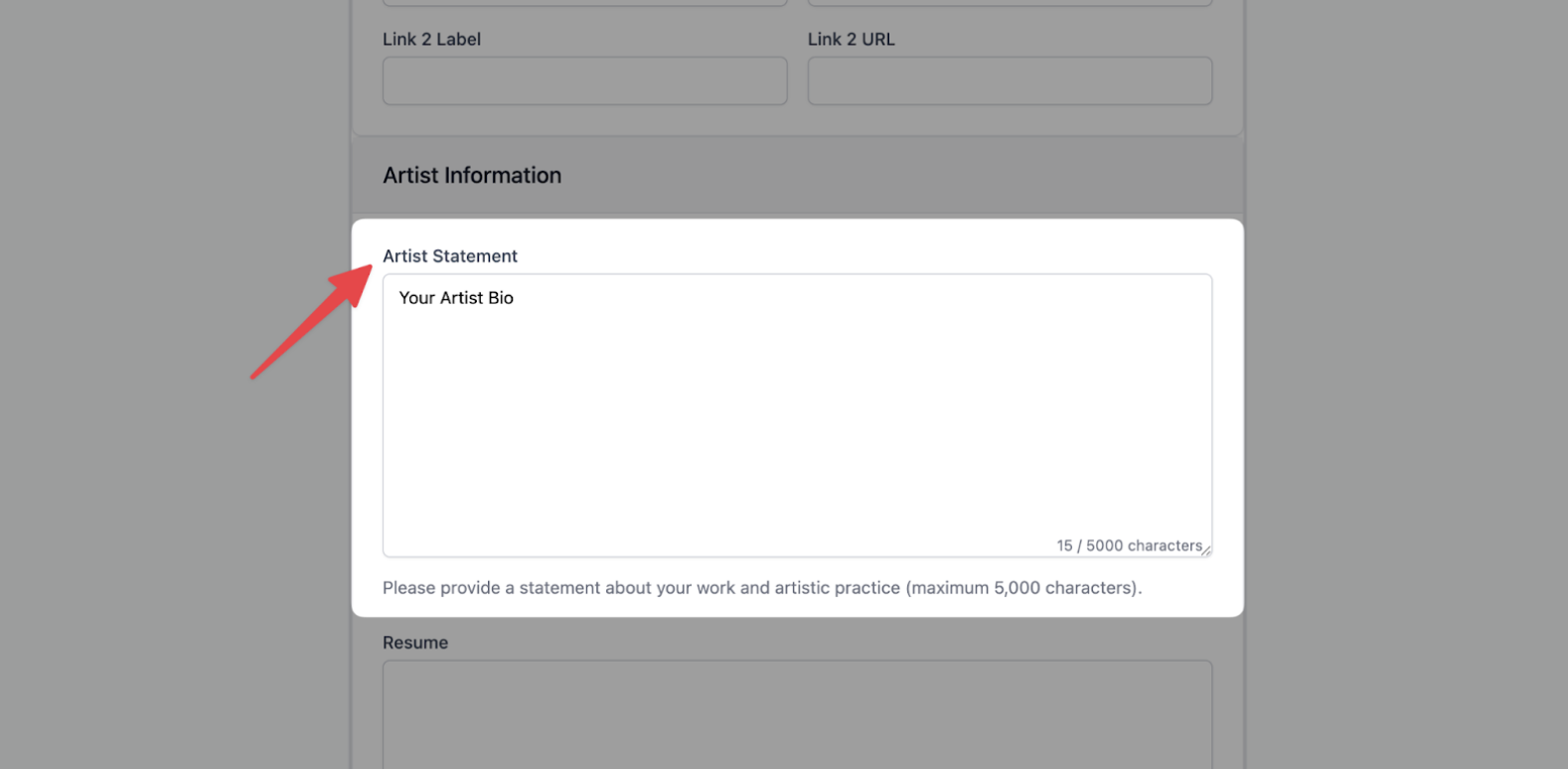Your artist bio is one of the first things jurors read in an open call.
Even though it’s short, it helps reviewers understand who you are, the kind of work you make, how long you’ve been in the art field, and whether you’re a good fit for their show.
If you’ve applied through platforms like EntryThingy (now with a new launch), you’ve seen that your bio sits right next to your artwork in the submission.
Users with a statement/bio have a 35.3% higher acceptance rate than users without one.
Admins often check it to get a quick sense of your background and artistic direction before they make decisions.
To help you write a stronger bio, here are 7 examples you can use for inspiration.
After that, we’ll show you how to update your bio inside EntryThingy so your next entry looks complete.
Why Your Artist Bio Is Important in Open Calls?
Your bio is important because it helps jurors understand who you are before they look closely at your work.
In most open call reviews, admins open your entry, view your images, and immediately check your bio to see your background, your experience level, and the themes you explore.
This helps them decide whether you’re a good fit for their exhibition or community.
Since accepted artists represent the show, organizers want to make sure your style, voice, and professionalism align with what they’re looking for.
In short, your bio gives reviewers essential context that supports your artwork and can influence how they interpret your submission.
7 Artist Bio Examples That Help You Stand Out
Below, I’ll showcase some examples inspired by the artist bios submitted on EntryThingy.
1. New Graduate Artist Bio
This bio is clean and direct, making it especially useful for emerging artists transitioning into open-call submissions.
Luca mentions selection in juried student exhibitions and briefly explains the direction of his current work.

See more new graduate bio examples and tips →
2. Multidisciplinary Artist Bio
Maya works across multiple mediums, and this bio shows how to keep things cohesive.
She focuses on one central theme (sensory memory) and supports it with a quick mention of juried exhibitions, which reassures jurors she's actively participating in open calls.

See more multidisciplinary artist bio examples and tips →
3. Professional Artist Bio
This bio works well because James gets straight to the essentials: where he's based, what materials he works with, and the focus of his practice.
Mentioning several juried shows helps reviewers immediately recognize experience and commitment.

See more professional artist bio examples and tips →
💡 Submitting to open calls? Join 166,000+ artists using EntryThingy to apply to shows hosted by 2,500+ galleries worldwide.
Create Your Account for Free4. Emerging Artist Bio
This example shows how an early-career artist can be clear and confident without overexplaining.
Sara sets the scene with her location, describes her medium, and mentions recent juried exhibitions, enough to help jurors understand her direction without needing a long resume.

See more emerging artist bio examples and tips →
5. Self-Taught Artist Bio
Nina keeps things simple by naming her medium, describing her focus, and showing participation in open-call group shows.
It's a strong template for artists who don't have formal training but still want to look professional to jurors.

See more self-taught artist bio examples and tips →
6. Conceptual Artist Bio
This bio is a great example of how to communicate a clear artistic concept in just a few lines.
Elisa explains the idea behind her work, the materials she uses, and the questions she explores.
It's concise yet thoughtful, which helps jurors quickly understand the intention and depth of her practice.

See more conceptual artist bio examples and tips →
7. Painter Bio (Abstract, Figurative & More)
This bio works because Noah focuses on the visual experience of his work rather than listing exhibitions or credentials.
He explains the mood, methods, and themes behind his abstract paintings, giving jurors a clear sense of what his pieces explore without overwhelming them.

See more painter bio examples and tips →
Join 166K+ Artists Using EntryThingy to Apply to Open Calls
If you’re applying to open calls, having your artist bio ready in one place makes the entire process smoother.
That’s why so many artists use EntryThingy, a platform where you can discover active open calls, build your artist profile, and submit your work in just a few steps.
With an EntryThingy artist account, you can:
- Create or update your artist bio
- Add your resume (Have a look at artist resume examples)
- Upload your strongest pieces
- Store your portfolio details in one place
- Apply to open calls as soon as they’re published
Your bio becomes part of your profile, and jurors can view it right alongside your images when they review entries.
Once you save it, you don’t need to rewrite it for every submission, it’s automatically included.
If you want an easier, more organized way to present yourself to jurors, joining the artists already using EntryThingy is a great place to start.
Just create your profile, add your bio (like the image below), and you’re ready to submit your next entry.

💡 Submitting to open calls? Join 166,000+ artists using EntryThingy to apply to shows hosted by 2,500+ galleries worldwide.
Create Your Account for FreeA Note About Artist Profile Statement
We recently updated "Artist Statement" to "Artist Profile Statement" on EntryThingy. Your Artist Profile Statement is a general statement about you as an artist that you write and manage in your profile settings.
When you apply to a call that requests an Artist Profile Statement, it will automatically populate from your profile and appear greyed out (non-editable) during the application process. This is because your Artist Profile Statement is managed at the profile level, not per individual call.
To edit or update your Artist Profile Statement, simply go to your artist profile settings. Learn more about the different types of statements and descriptions.